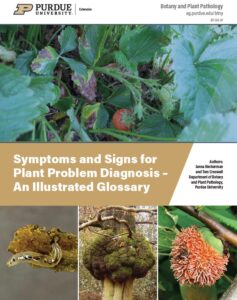Do your landscape plants have cankers, mosaics, galls, mummies, or witches’ brooms? These and other symptoms are often difficult for the average homeowner to understand, let alone visualize. Purdue Extension staff can often assist with diagnosing plant diseases.
Additionally, Purdue Extension specialists Janna Beckerman (retired) and Tom Creswell authored the publication, “Symptoms and Signs for Plant Problem Diagnosis – An Illustrated Glossary.” It is designed to help homeowners and professionals understand plant disease symptoms and signs, one of the first steps in correctly diagnosing a disease or abnormality and subsequently formulating a management strategy, if needed. I’ll use some verbiage and examples from the publication.
- Figure 1. ‘Symptoms and Signs for Plant Problem Diagnosis-An Illustrated Glossary’ Authored by Dr. Janna Beckerman and Dr. Tom Creswell.
I’ll cover a few of the more common symptoms I’ve encountered when working with local homeowners as an Extension Educator, plus others that you may notice in plants.
There is a difference between symptoms and signs. A symptom is a change in plant growth or appearance that may indicate or describe a plant health problem. However, for any given symptom, there could be multiple causes of that observed change. A sign, on the other hand, is the evidence of the damaging factor—the actual cause of the problem that allows for a conclusive diagnosis of a plant health issue. Examples of common signs include catching a fat green tobacco hornworm chewing on your tomato plants or seeing the fluffy white mycelia of white mold in beans. A parallel in a crime scene might be the presence of the perpetrator’s fingerprints, for example.
Chlorosis is the yellowing or loss of color in normally green tissues due to the destruction of chlorophyll. Chlorophyll is an essential component of photosynthesis in plants, and it makes leaves green. Insects, pathogens (causes of plant diseases, such as fungi or bacteria), and abiotic disorders (non-living, non-infectious factors, such as environmental factors or nutrient deficiencies) can cause chlorosis.
Cankers are localized, cracked, or sunken lesions on a branch, stem, or trunk. Growth can girdle infected plant parts, resulting in blight or dieback. Cankers are typically caused by bacterial or fungal pathogens.
Galls are a tumor, swelling, or outgrowth of disorganized plant tissue. They are commonly found on leaves, twigs, or crowns of plants. They can be caused by pathogens, insects, or as a response to injury.
Leaf spots are localized destruction of the chlorophyll by the feeding of pathogens or sucking insects. There are many types of leaf spots, caused by fungi, bacteria, nematodes, viruses, insects or mites, algae, and abiotic disorders.
Mosaics are dark green, light green, and/or yellow areas forming a variegated pattern. They are caused by a virus.
Mummies are dried, shriveled fruit, partly composed of fungal material. Fungi cause mummies.
Necrosis is the term for the death of plant tissue, resulting in the tissue turning black or brown.
Needle cast is a name given to foliar diseases in conifers where plants shed or cast off their needles. Fungal pathogens can cause needlecast diseases, although some insects can also consume needles with similar effects.
A witches’ broom is an abnormal, brush-like growth of many weak shoots. It often looks somewhat similar to broom bristles on a plant. Insects, fungi, bacteria, or viruses can cause witches’ brooms.
Consult the referenced publication for illustrations and descriptions of a wider array of symptoms and signs. Find it at Purdue Extension’s Education Store, https://edustore.purdue.edu/. It has a modest price of $7.50, not including shipping fees. You can also download the publication for free at https://www.extension.purdue.edu/extmedia/BP/BP-164-W.pdf
If you need help in diagnosing your plant problems, you can submit a sample to the Purdue Plant and Pest Diagnostic Laboratory for a modest fee. Information about submitting a sample can be found at their website: https://ag.purdue.edu/department/btny/ppdl/submit-samples/submit-sample.html
